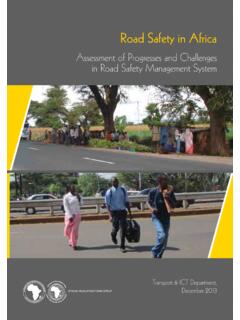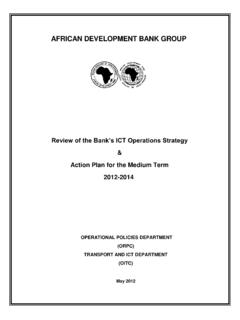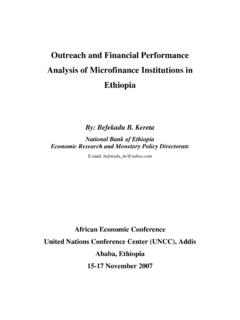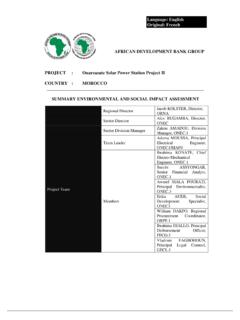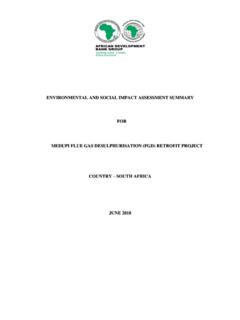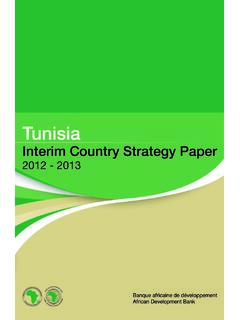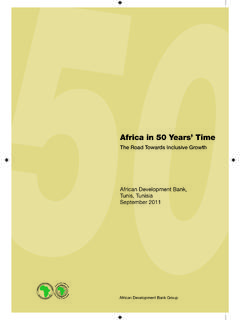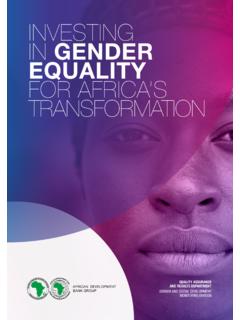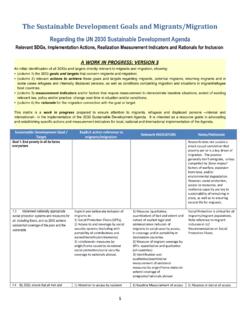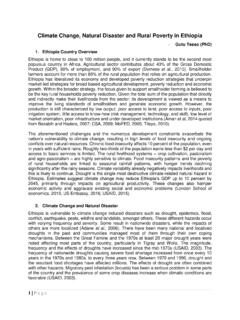Transcription of Cereal Crops: Rice, Maize, Millet, Sorghum, Wheat
1 BACKGROUND PAPER. Cereal Crops: rice , maize , millet , sorghum , Wheat Cereal Crops Prepared by: Dr Harold Macauley, Director General of Africa rice Co-conveners: Tabo Ramadjita, ICRISAT. EXECUTIVE SUMMARY. Africa with its vast land area covering 3 billion ha has billion ha of agricultural land out of which only 252 million ha ( %) is arable (2011, FAO). Africa is the center of origin and also a major producer of several cereals like sorghum , pearl millet , finger millet , teff and African rice . Another major Cereal , maize , has overtaken these traditional cereals while Wheat is widely cultivated in North Africa and in Sudan and Ethiopia. Agriculture is the engine for growth' in Africa. With subsistence agriculture practiced by majority small holder farmers, yield gaps are high and poor soils, amongst other constraints add to the difficulties for sustainable farming and incomes. Cereals like sorghum , Millets, Wheat , maize and rice are major staple foods of the most population.
2 These cereals are grown over an area of m ha producing 162 m tons (Table1). Table 1: Area and production of selected Cereal crops Africa (2012). Crop Area (ha) Production (t). maize 34,075,972 70,076,591. millet 19,998,008 16,008,838. rice , paddy 11,206,813 28,798,202. sorghum 23,142,595 23,350,064. Wheat 10,224,952 24,704,201. Total 98,226,080 162,422,507. FAOSTAT | FAO Statistics Division 2015 | 04 October 2015. maize is a major staple food crop grown in diverse agro-ecological zones and farming systems, and consumed by people with varying food preferences and socio-economic backgrounds in sub-Saharan Africa (SSA). The central role of maize as a staple food in SSA is comparable to that of rice or Wheat in Asia, with consumption rates being the highest in eastern and southern Africa (ESA). Of the 22 countries in the world where maize forms the highest percentage of calorie intake in the national diet, 16 are in Africa.
3 maize accounts for almost half of the calories and protein consumed in ESA, and one-fifth of the calories and protein consumed in West Africa. An estimated 208 million people in SSA depend on maize as a source of food security and economic wellbeing. maize occupies more than 33 million ha of SSA's estimated 200 million ha of cultivated land. Considering the low average maize grain yields that are still pervasive in farmers' fields, meeting the projected increase demand for maize grain in Africa presents a challenge. sorghum is the second most important Cereal after maize with 22% of total Cereal area, followed by millets (pearl and finger) with 19% of the total Cereal land coverage. The continuing demand for these two crops is reflected in the trend for increasing area under sorghum and millets in Africa over the last fifty years. Unfortunately however, crop productivity has not kept pace with increasing demand, due mainly to a lag in crop improvement efforts in sorghum and millets, relative to other cereals, and the extreme environmental conditions and resource constrained, low-input farming systems where these crops are grown.
4 Furthermore, in such dryland environments, the issues of climate variability, change and land degradation are acute with a lack of progress the result of neglect, remoteness i and weak national institutions. Despite these factors there is a strong case for stepping up the efforts towards development of technologies (germplasm improvement, agronomic management), markets and institutions to advance the case for sorghum and millets in the dryland tropics of Africa. rice has become a highly strategic and priority commodity for food security in Africa. Consumption is growing faster than that of any other major staple on the continent because of high population growth, rapid urbanization and changes in eating habits (Seck et al., 2013). It is the single most important source of dietary energy in West Africa and the third most important for Africa as a whole. Although local rice production increased rapidly after the 2007-2008 food crisis, a key problem facing the rice sector in Africa in general is that local production has never caught up with demand.
5 The continent therefore continues to rely on importation to meet its increasing demand for rice . Wheat is grown on around 10 million ha in Africa. It is a major staple crop for several countries and an imported commodity in all of Africa. In all African countries, Wheat consumption steadily increased during the past 20 years as a result of growing population, changing food preferences and socioeconomic change associated with urbanization. African countries are the world's biggest Wheat importer with more than 45 m t in 2013 at around 15 billion US$. Wheat imports account for 60% of African's Wheat consumption and 80% of Sub-Saharan (SSA). countries. North African countries have the highest per capita Wheat consumption and Wheat provides up to 50% of daily calories and protein. In rapidly urbanizing sub-Saharan Africa, Wheat consumption is expected to grow 38% by 2023 with imports already at 23 m tons of Wheat in 2013 at a cost of $ billion.
6 Considering the growing importance Wheat has for food security in Africa, African Union Heads of State endorsed their Agriculture Ministers'. endorsement in January 2013, to add Wheat to the list of strategic crops for Africa. Cereal yields in Africa are lower than half the world average. The average fertilizer (N + P2O5). consumption is kg/ha (2010, FAO) which is 1/6th compared to the world consumption of kg/ha. Increasing productivity of the small holder farmers, bridging the yield gaps by providing appropriate inputs along with improved technologies such as stress resistant and high yielding varieties will be a step towards agricultural transformation in Africa. Africa faces a wide range of challenges in the production of the five major cereals considered in this Work Stream - rice , maize , millet , sorghum and Wheat . Key among these challenges are: 1. The impact of climate change : Global agriculture is facing the probable impact of global warming.
7 Recent studies suggest that the production of major commodities has declined since 1980 due to global warming (Lobell et al. 2011). It is estimated that, given current warming trends in sub-Saharan Africa, the production of major cereals could decline by as large as 20% by mid--century (Schlenker and Lobell 2010). The poor who depend on agriculture for their livelihoods and are less able to adapt will be disproportionately affected (World Bank 2007). A recent study estimates the annual costs of adapting to climate change in the agricultural sector to be over USD 7 billion (Nelson et al. 2009). 2. Land degradation and persistent biotic and abiotic stresses: In addition to inherently high climate variability, the looming threat of higher temperatures and more vicious droughts (arising from climate change ) is a major concern. Further, high incidences of diseases, insect-pests, and parasitic plants, and sub-optimal soil nitrogen have also presented a continuous challenge to Cereal productivity in SSA.
8 Ii 3. Rapid population growth across Africa and associated difficulty in meeting the projected demand for food: The high population growth in Africa is giving rise to rapidly increasing demand for food. The UN's Human Development Indices suggest that the dryland areas in West and Central Africa (WCA) and East and Southern Africa (ESA) remain among the poorest and most food-insecure places in the world. 4. Poor mechanization: The low level of mechanization in African agriculture has continued to serve as a huge impediment towards advancing Cereal production, especially of Wheat and rice which, in turn, results in the high cost of producing these crops. 5. Inadequate or weak policy environment: Most government policies are inappropriate and inconsistent, and do not provide an enabling environment for the development of the Cereal sector in Africa. This includes low funding of the national agricultural research and extension institutions, leading to ineffective technology development and diffusion mechanisms.
9 Lack of investment in infrastructure such as roads, storage and market facilities handicaps the potential role of the private sector. 6. Dwindling financial resources for Research and Development: There has been a steady decline in the level of financial support by the major donors to agricultural research, over the last 5 years. Many CGIAR centres have had to cut back their financial allocations to these cereals. Good efforts are being made by the CGIAR Centres in collaboration with the national institutions and other key stakeholders to address these challenges and improve the productivity of maize , sorghum , millets, rice and Wheat in Africa, to meet the increasing demands. The CGIAR Centres spearheading the development of these important cereals have put together strategies for re-invigorating the process of developing and disseminating the requisite technology that would increase the production and productivity of the cereals to meet the increasing demand in Africa.
10 For example: sorghum , Pearl millet and finger millet : Additional support is required to enable the strengthening of the Crop Development Process, strengthen the seed production and delivery systems for improved varieties, empower farmers to enable them manage their natural resource base in a sustainable manner using integrated soil fertility and crop- livestock systems management ( livestock providing a better enterprise option for smallholder farmers), crop rotation ( the important of cash crops like cotton in terms of residual P and N for the subsequent legume and Cereal crops, respectively), minimum or conservation tillage systems, expedite the scaling out of new sorghum and millets technologies including products development, enable Farmers' access to production inputs and markets, and strengthen and sustain the technology delivery system. maize : Support is needed to scale-up and deliver improved multiple stress tolerant, nutrient-use efficient and nutritious maize varieties, Curb the spread and impact of MLN, strengthen the maize breeding pipeline for enhancing capacity of NARES and SMEs, sustainable intensification of maize -based agri-food systems, and develop better Aflasafe products, aflatoxin management systems and delivery mechanisms.
